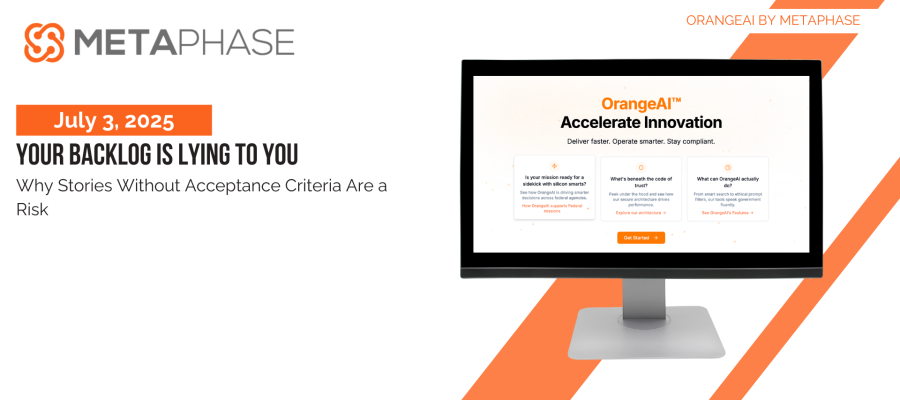
Agile delivery is only as good as the clarity and traceability of the work that teams are asked to deliver. Yet in many federal and enterprise teams, backlogs are filled with user stories that look right at first glance but are fundamentally broken under the surface.
They read like this:
- “As a user, I want to log in so that I can access my dashboard.”
- “As a case worker, I want to view claims data.”
- “As a service member, I want to check my benefits status.”
These are reasonable starting points. But on their own, they are not deliverable. They are not testable. And they are certainly not traceable to any measurable outcome.
They are just placeholders. And placeholders cannot support secure, high-assurance delivery.
The Illusion of Agility
Most backlogs today are managed in tools like Jira, Azure DevOps, or Trello. These tools do not create clarity by themselves. They simply store what the team puts into them.
When stories lack detail, context, or testable criteria, they create waste. Engineers spend time guessing. Product owners go back and forth clarifying. QA teams write tests from scratch. And security reviewers are left wondering how any of it ties back to policy requirements or user needs.
In agile terms, the Definition of Ready is frequently ignored or inconsistently enforced. In policy terms, the chain of custody from requirement to implementation is broken.
This may seem like a delivery problem. In regulated environments, it quickly becomes a compliance risk.
Why Acceptance Criteria Matter
Acceptance criteria are not optional. They are the bridge between intent and testability. Without them, a user story is just an idea. With them, it becomes a contract that can be validated.
Well-written acceptance criteria enable:
- Automated testing, including behavior-driven development (BDD)
- Security verification, mapped to control objectives
- Traceability, allowing teams to show what was delivered and how
- Shared understanding, reducing rework and friction during sprints
This is not just good practice. It is required under several delivery and compliance frameworks.
For example, NIST’s Secure Software Development Framework (SSDF) requires documented, testable acceptance criteria that link to system-level security objectives [1]. FedRAMP requires control traceability from documentation to implementation [2]. And SAFe emphasizes testable user stories as part of its program increment planning guidance [3].
In short, if you cannot validate your stories, you cannot validate your system.
How This Shows Up in the Real World
Consider a team working on a citizen-facing claims portal. A product owner adds the story:
“As a user, I want to upload documents to my application.”
At first glance, it seems simple. But without additional context or criteria, the engineering team has no answers to key questions:
- What file types are allowed?
- What size limits should be enforced?
- Should the upload be encrypted at rest?
- What happens when an upload fails?
- Is this user authenticated?
The team improvises. They make assumptions. QA does not know what edge cases to test. Security reviewers flag gaps after the fact. Rework follows.
Multiply this by 200 stories in a backlog, and you have a system that is unpredictable and unprovable.
What Good Looks Like
A well-structured user story should include:
- A clearly defined actor (persona)
- A specific action with context and constraints
- Acceptance criteria written in a format that allows for automated or manual validation
In high-assurance environments, this often includes Gherkin syntax:
GIVEN the user is authenticated and is on the document upload page WHEN the user selects a valid PDF under 10MB and clicks “Submit” THEN the file is stored encrypted at rest and a success message is displayed
This format is more than just syntax. It allows teams to write tests, build security controls, and create audit evidence directly from the story.
Automating the Pain Away
Writing these stories and criteria manually is time-consuming. That is where tooling matters.
Platforms like ChallengeAC and ChallengeTDD are designed to turn goals into testable artifacts. ChallengeAC generates epics, stories, and acceptance criteria based on user inputs, personas, or objectives. ChallengeTDD connects those stories to traceable tests, mapped to compliance controls and technical verification.
Together, they reduce backlog friction and produce work that is ready to build, test, and defend in front of an auditor.
This is not about outsourcing product thinking. It is about removing the overhead that makes clarity optional.
The Impact of Getting It Right
Teams that enforce testable story structures consistently report:
- Lower defect rates due to shared understanding of intent
- Faster sprint velocity with less clarification and rework
- Higher test automation coverage driven by Gherkin-ready criteria
- Stronger traceability from requirements to delivered functionality
These outcomes matter. Especially in programs with compliance mandates, public-facing features, or multi-stakeholder review processes.
Questions to Ask Your Team
If you want to evaluate your current backlog quality, ask:
- How many of our stories have acceptance criteria?
- Are those criteria testable and repeatable?
- Can we trace features back to requirements and policies?
- Are engineers guessing what “done” looks like, or is it defined?
If the answers are inconsistent, your backlog is a liability.
Final Thought
User stories are not just planning artifacts. They are the blueprint for your system. If they are incomplete, the system will be too.
In high-trust environments, ambiguity is a risk. Clarity is a control.
The future of agile in government is not about going faster. It is about delivering with confidence, traceability, and shared understanding. That starts with a backlog that tells the truth.
To discover more about the ChallengeAI suite of tools, visit https://challengeai.metaphase.tech/
References:
[1] NIST Secure Software Development Framework (SSDF), NIST SP 800-218
[2] FedRAMP Security Assessment Framework, General Services Administration
[3] SAFe 6.0 Program Increment Planning Guidelines, Scaled Agile Framework

